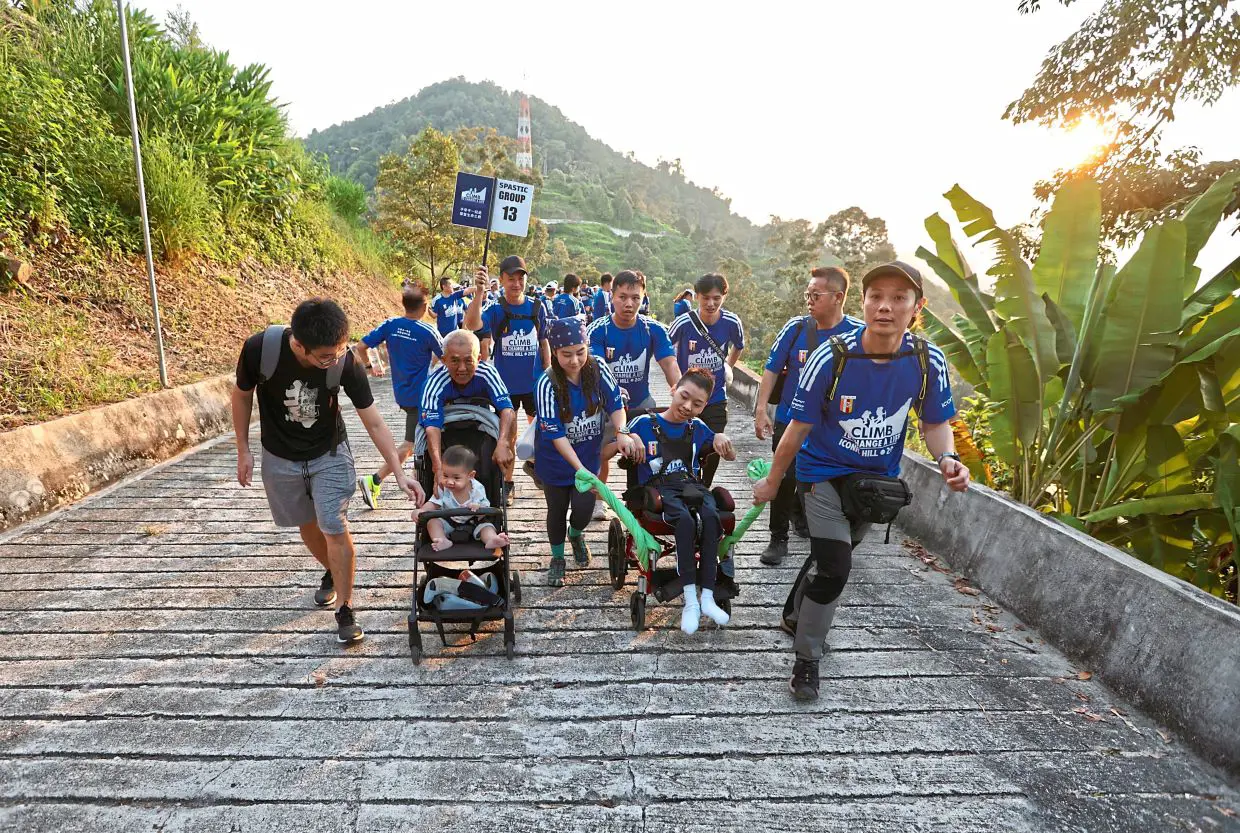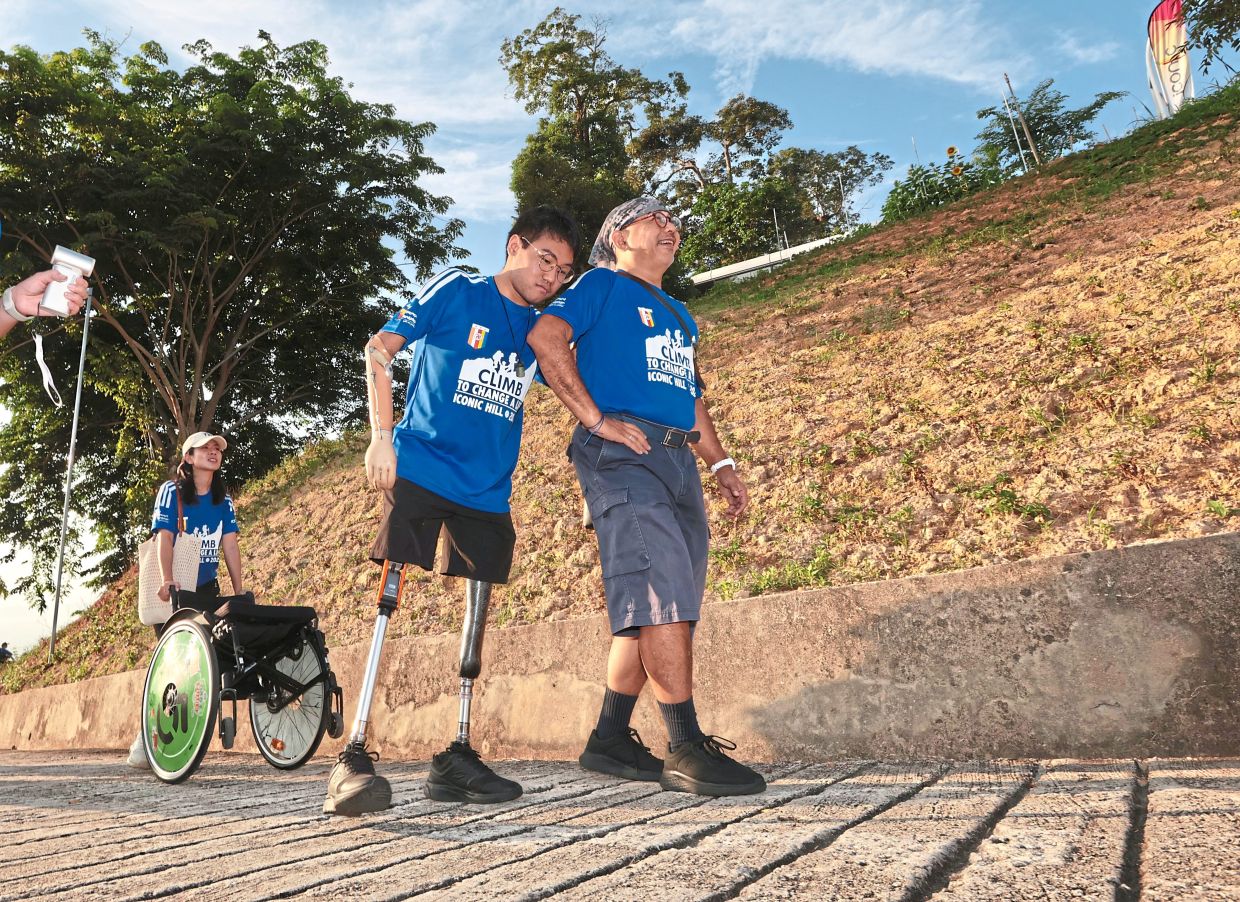
Participants taking on the uphill challenge of climbing Iconic Hill during “Climb To Change A Life” hiking event in Paya Terubong, Penang. (July 20, 2025) — ZHAFARAN NASIB/The Star.
GEORGE TOWN: Some came in wheelchairs, some used walking aids and some could only feel their way ahead.
But with determination and some help, about 60 differently-abled individuals made it to the top of Iconic Hill in Paya Terubong yesterday.
From the peak, which is high as a 73-storey tower, they watched the iconic Komtar tower, both bridges, Penang Hill, the Bayan Lepas industrial zone and even the shores of Kedah bathed in sunrise.
Among the climbers was Serena Yeoh Jing Han, 10, who lives with cerebral palsy.
Born with the condition, Yeoh did not learn to walk until she was five.
Yesterday, she pushed her limits by walking all the way up, one step at a time.
“She got up from bed immediately this morning (yesterday), excited and ready. She is not used to walking without support, but she was determined to finish the hike, and she did,” said her mother, Teh Mong Ling, 46.
Three-year-old Syed Aydan Mateen Syed Mustaqim, also got out of his stroller to complete the hike.
His father, Syed Mustaqim Syed Zainol Abidin, 39, smiled as he recalled the journey with his son, who lives with cerebral palsy.
“Usually, we only bring him to the playground. But today, we saw something different in him.
“His curiosity lit up, he was learning from everything he saw and felt,” he said.
From toddlers to teens, the event drew people from all walks of life.
S. Puvarasan, 19, lost his sight to eye cancer when he was only one-year-old.
“I do not remember what the world looks like. But I could feel the sunshine, hear the laughter and breathe in the fresh air.
“This moment meant everything. It showed me that we’re not alone and we can lift each other up,” he said.
Themed “Climb to Change a Life”, the event was organised by Pertubuhan Hui Yin Seh, a Buddhist association, with the support of some 600 volunteers.
Hui Yin Seh chairman Khiah Hock Leong said the organisation wanted the differently-abled community to feel the joy of nature.
“But more than that, we want society to better understand their needs and learn to appreciate life a little more deeply,” he said.
Paralympic swimmer Zy Kher Lee, 18, also took part in the event, which was co-organised with his Zy Movement Foundation.
Zy Kher, who has prosthetic legs, walked to the very top with his father Walter Lee.
“Many children with mobility challenges rarely get a chance to enjoy hills or nature. Even climbing a small hill with friends can be life-changing.
“It’s a learning journey for them, and for everyone involved,” said Walter, 60.
Krisana Lalai, 56, from Bangkok, Thailand, also turned up to support the cause.
He founded the Friendly Design For All Foundation, a human rights organisation focused on promoting equal rights to accessibility, particularly for people with disabilities.
Paralysed from the waist down after an accident at 29, Krisana said he was moved by everyone’s spirit.
“This activity brings compassionate hearts together. It creates something meaningful, not just for those with disabilities, but for the families and friends who support them.
“It sends a strong message of unity and inclusion,” he said.
Penang youth and sports committee chairman Daniel Gooi lauded the initiative and reaffirmed the state’s commitment to inclusivity.
“This event reminds us that no one should be left behind,” he said on the sidelines of the event.
“Since 2016, our Accessibility Action Group has worked to make Penang more friendly to those with physical challenges.
“We’re not done, but we’re on the right path,” he said.
Besides the hike, participants also joined a series of telematch games and performances at the hilltop.
By LO TERN CHERN, the Star






